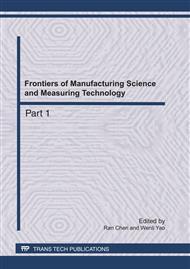p.1110
p.1114
p.1119
p.1123
p.1129
p.1133
p.1141
p.1146
p.1151
Sr(II) Removal from Aqueous Solution by Bacillus cereus Biomass, Equilibrium and Kinetic Studies
Abstract:
Batch experiments were carried out to determine the capacity of Bacillus cereus biomass to adsorb Sr(II) ions from aqueous solution with respect to pH, initial Sr(II) concentration, contact time and biomass dose. The experimental data were modeled by Langmuir and Freundlich isotherm models. Langmuir model resulted in the best fit of the adsorption data. The maximum adsorption capacity for Sr(II) was 78.34 mg/g. The best correlation was provided by the second-order kinetic model, implying that chemical sorption was the rate-limiting step. The practical implication of this study is the development of an effective and economic technology for Sr(II) removal from contaminated waters.
Info:
Periodical:
Pages:
1129-1132
Citation:
Online since:
May 2011
Authors:
Keywords:
Price:
Сopyright:
© 2011 Trans Tech Publications Ltd. All Rights Reserved
Share:
Citation:


